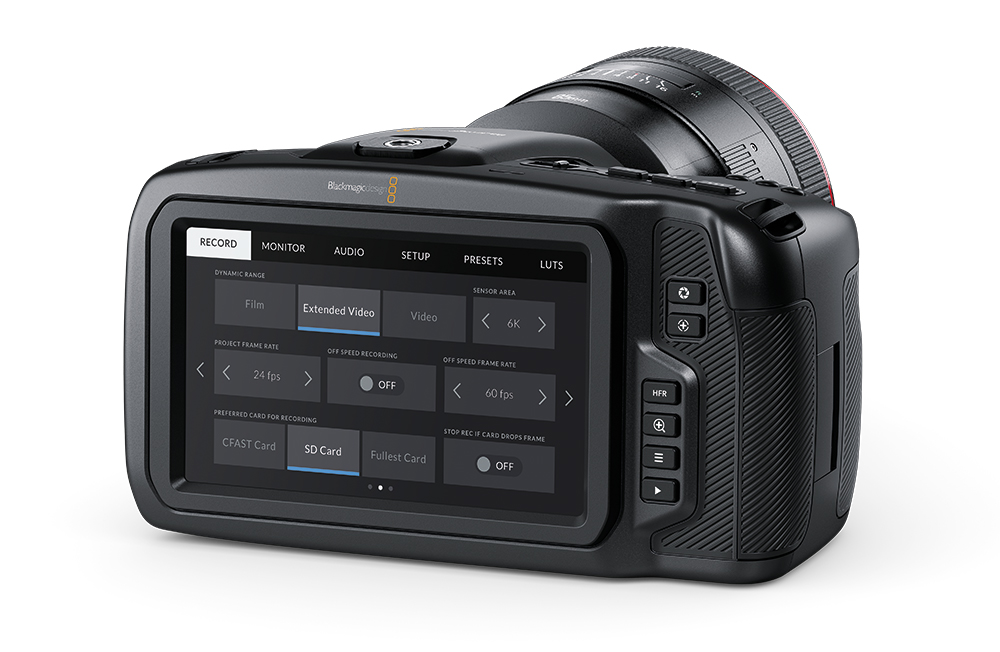
Review: Blackmagic Pocket 6K Camera
Posted on Nov 4, 2019
We love the Blackmagic Pocket 4K camera; but maybe we love the new Pocket 6K more! DOP Ash Connaughton was going 4K but decided to go bigger
Words Ash Connaughton / Pictures Blackmagic Design
Blackmagic Design recently released its new 6K Pocket Cinema Camera, a Super 35, 6K cinema camera with 13.5 stops of dynamic range. Plus Blackmagic Raw, ProRes and Davinci Resolve thrown in for free. So how does this new offering compare to the ever popular Pocket 4K? Let’s dive into the numbers, looking at everything from frame rates and resolutions to dynamic range and sensor size!
Similarities
So first off what is the same? The cameras look very similar externally apart from the elongated lens mount on the Pocket 6K. Because of this, some cages don’t fit both bodies, but the Smallrig cage fits both perfectly. The Tilta cage now has a replacement top plate to make it work with the 6K. Both cameras can shoot Blackmagic Raw and Prores, both cameras have Cfast 2.0, SD card and USB type C recording capabilities, as well as a locking DC power connector, HDMI out and mini XLR connectivity. Both cameras also use the LPE6 style battery which runs the cameras from 20-45 mins depending on use. So not great! Personally I suggest you just run the camera from a V mount battery for most scenarios unless you desperately need to have the smallest camera package possible. If that is the case then be prepared to carry an abundance of LPE6 batteries!
Both cameras share the large rear touchscreen. While sharp and reasonably colour accurate, even at 100% it’s not bright enough for use in direct sunlight. In the shade its fine, so I recommend a sun hood of some sort if not also an external monitor. The OS however is beautiful; it’s very simple and intuitive to navigate and use, everything is very easy to access and change.
There is no change to the AF abilities of the camera over the 4K. It’s still touch to focus on lenses that support AF and does not offer any form of tracking or continuous AF.

Differences
Now what’s different? The most obvious difference (aside from the price, £1194 vs £2430 including VAT in the UK), is the resolution with the Pocket 6K offering 6K at a resolution of 6144×3456, 16×9 aspect ratio, at up to 50fps as its full sensor readout with Blackmagic Raw, which gives a crop factor of 1.558x. Compare the Pocket 4K at 4K DCI 4096×2160 up to 60fps Braw. If you want 60 frames on the Pocket 6K you have to step down to the 5.7K Braw option which is a very very slight crop. If you only want to shoot in 4K, you are limited to Prores only, whereas the Pocket 4K can take advantage of 4K in Blackmagic Raw.
In terms of higher than 60p frame rates the Pocket 6K offers up to 120fps at a 2.8K (2868×1512) windowed sensor mode in Braw; In Prores you can shoot up to 4K 60fps DCI or UHD. Or up to 120fps in 1080p but at a similar crop to the 2.8K Braw Mode. With the Pocket 4K both 120fps 1080p and 4K 60fps are available in Prores and Braw.
The Pocket 6K comes with a Canon EF mount, meaning there is a very wide range of glass available to use. The downside to this over the Pocket 4K is that with an MFT mount you can adapt pretty much any lens to the system, including PL. The EF mount on the 6K just isn’t as friendly in terms of adapting lenses. Some PL lenses will work with an adapter, others won’t but with a very wide range of EF glass on the market there are plenty of options for lenses.
Next up is sensor size. The Pocket 6K has a Super 35 sensor measuring at 23.10mmx12.99
against the Pocket 4K’s Four Thirds sensor which measures at 18.96mmx10mm. The Pocket 6K is
on the smaller side for a Super 35 sensor when compared to cameras like the RED Dragon X (25.6×13.5 mm) but it’s larger than the URSA Mini 4K which has a sensor size of 22mmx11.88mm.
 The Pocket 6K has the same large rear touchscreen as the 4K
The Pocket 6K has the same large rear touchscreen as the 4K
Both cameras share the dual native ISO feature of 400 and 3200
Compare and contrast
An interesting comparison is that with the sensor size of the Kinefinity Terra 4k which is smaller than S35 but bigger than MFT and measures in at 19.5×13.3mm. This should give you a decent idea about where the two sensors measure up in comparison to other cameras on
the market.
Now in terms of rolling shutter, the Pocket 6K has a readout of 19.8ms and the 4K is a little lower at 16ms. But both sit quite far from the 2ms of the Arri Alexa. But not as bad as the 24ms of the Sony A7S.
Both cameras can record in Blackmagic Raw as I’ve mentioned earlier and it’s a fantastic codec that works seamlessly with Davinci Resolve. The Pocket 6K does have better highlight roll-off than the 4K, giving it the impression of more dynamic range. One thing I’ve noticed in all my tests and from the footage I’ve seen comparing the two cameras online is that the Pocket 6K in my opinion has nicer colours! The 4K has a clear green shift, more noticeable than the slight magenta of the 6K. This is something that can easily be corrected either way but I’d say the 6K certainly has nicer colours out of the box.
Dual ISO
So what about ISO and noise performance? Both cameras share the Dual Native ISO feature of 400 and 3200 ISO with a max ISO of 25,600, although the 400 ISO option maintains the most dynamic range. The 3200 ISO is very usable, and especially with the noise reduction feature in Resolve it works fantastically. One thing to note is that with the 6K, if you export 4K in post it will look cleaner than the 4K to the resizing of the pixels, effectively shrinking the noisy parts of the image; worth bearing in mind should you want to export 4K.
 The Pocket 4K is a hugely popular camera, but the 6K offers some advantages over its brother
The Pocket 4K is a hugely popular camera, but the 6K offers some advantages over its brother
I personally chose the 6K for its larger sensor and native EF mount as well as options for resolution, such as the 120fps in 2.8K over the 120fps in 1080 on the Pocket 4K and better colours and highlight roll-off. I would however love 4K Braw in the 6K camera, but it would come with a heavy crop unless Blackmagic Design decided to implement pixel binning into their Raw codec, something of which they are not a fan. Pixel binning does have its issues like moiré and other artefacts but it would be nice to be given the option!
To sum up, you can’t really go wrong with either camera. Both offer a fantastic image for the price. The two cameras are very similar with subtle differences making them quite hard to choose between, with no clear better option as both have different limitations and features. You have to consider carefully which features matter to you.
Pricing at £2430/$2495.








